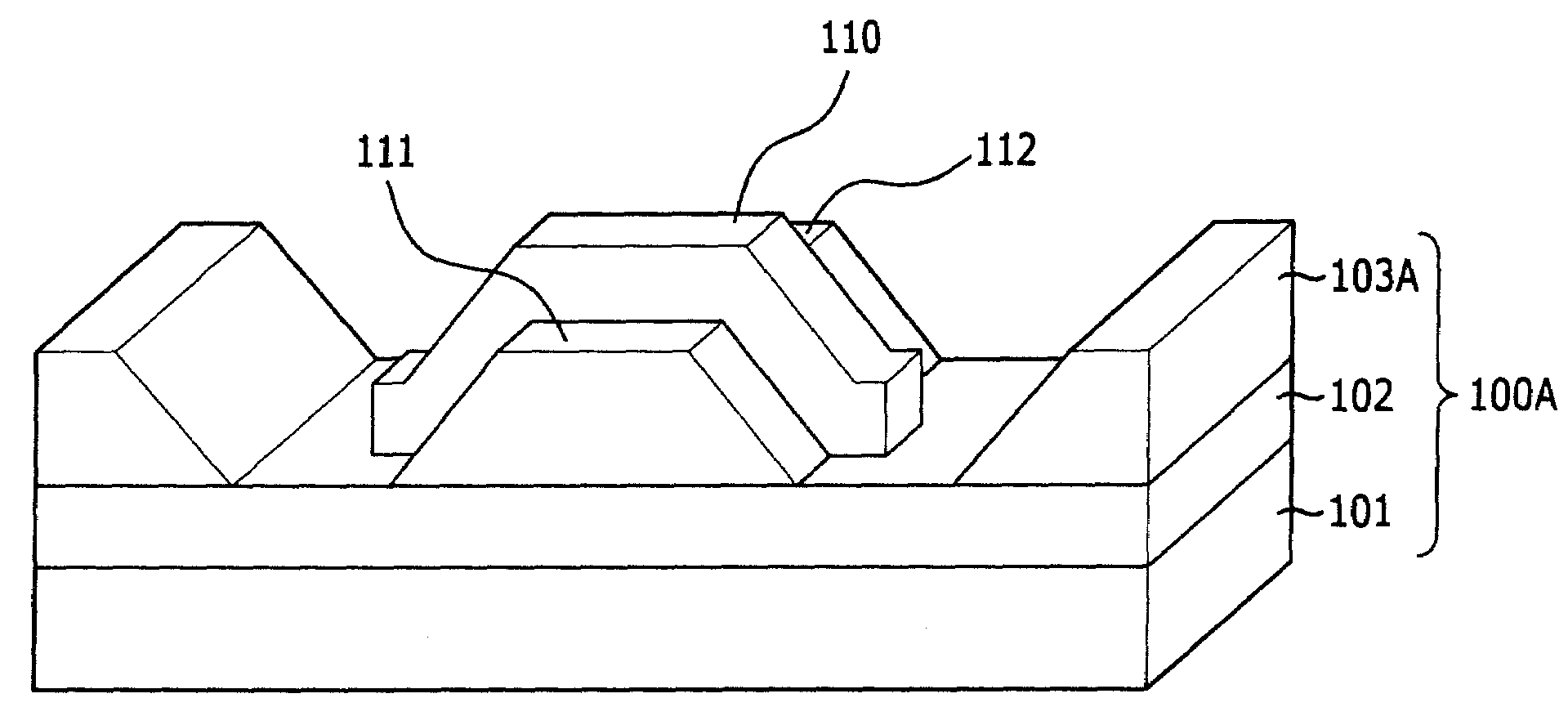Method for forming gate of semiconductor device
a technology of semiconductor devices and gate elements, applied in the direction of semiconductor devices, basic electric elements, electrical appliances, etc., can solve the problems of increasing leakage current, reducing threshold voltage, and crystal defects such as stacking faults, so as to prevent the characteristic and reliability of the device from being degraded
- Summary
- Abstract
- Description
- Claims
- Application Information
AI Technical Summary
Benefits of technology
Problems solved by technology
Method used
Image
Examples
embodiment 1
[0033]FIG. 4 is a perspective view of a triple gate formed by a method for forming a triple gate of a semiconductor device in accordance with a first embodiment of the present invention. FIGS. 5A to 5G are cross-sectional views illustrating a method for forming a triple gate of a semiconductor device in accordance with a first embodiment of the present invention.
[0034]Referring to FIG. 5A, a substrate 100 is prepared. The substrate 100 is a silicon-on-insulator (SOI) substrate and includes a support substrate 101, a buried insulation layer 102, and a semiconductor layer 103. The buried insulation layer 102 is formed of oxide to a thickness of approximately 100 Å or more, specifically, approximately 100 Å to approximately 1,000 Å. The semiconductor layer 103 is formed to a thickness of approximately 300 Å or more, specifically, approximately 300 Å to approximately 1,000 Å. The semiconductor layer 103 may include an epitaxial layer.
[0035]Referring to FIG. 5B, a buffer layer 104 and a ...
embodiment 2
[0046]FIGS. 6A to 6J are cross-sectional views illustrating a method for forming a triple gate of a semiconductor device in accordance with a second embodiment of the present invention.
[0047]Referring to FIG. 6A, a buffer layer 202 and a hard mask 204 are formed on a substrate 200. The buffer layer 202 is formed of oxide, for example, silicon oxide (SiO2). The buffer layer 202 may be formed by an oxidation process or a deposition process. In this embodiment, the buffer layer 202 is formed by the oxidation process. The hard mask 204 is formed of nitride, for example, silicon nitride (SiN or Si3N4). The hard mask 204 is formed by a low-pressure chemical vapor deposition (LPCVD) process. A photoresist pattern 206 is formed on the hard mask 204.
[0048]Referring to FIG. 6B, the hard mask 204 and the buffer layer 202 are etched by an etching process using the photoresist pattern 206 as an etching mask. Consequently, a hard mask pattern 204A and a buffer pattern 202A are formed. In this cas...
embodiment 3
[0062]FIGS. 7A to 7F are cross-sectional views illustrating a method for forming a recess gate of a semiconductor device in accordance with a third embodiment of the present invention.
[0063]Referring to FIG. 7A, a device isolation layer 302 is formed in a substrate 300 by a shallow trench isolation (STI) process, and a buffer layer 304 is formed on the substrate 300. The buffer layer 304 is formed of oxide, for example, silicon oxide (SiO2). Specifically, the buffer layer 304 is formed of a thermal oxide layer or a tetra ethyl ortho silicate (TEOS) layer. The buffer layer 304 may be formed by an oxidation process or a deposition process. The oxidation process includes a dry oxidation process or a wet oxidation process. The deposition process includes a CVD process or a physical vapor deposition (PVD) process.
[0064]Referring to FIG. 7B, a photoresist pattern 306 is formed on the buffer layer 304. The buffer layer 304 is etched by an etching process using the photoresist pattern 306 a...
PUM
| Property | Measurement | Unit |
|---|---|---|
| temperature | aaaaa | aaaaa |
| temperature | aaaaa | aaaaa |
| pressure | aaaaa | aaaaa |
Abstract
Description
Claims
Application Information
 Login to View More
Login to View More - R&D
- Intellectual Property
- Life Sciences
- Materials
- Tech Scout
- Unparalleled Data Quality
- Higher Quality Content
- 60% Fewer Hallucinations
Browse by: Latest US Patents, China's latest patents, Technical Efficacy Thesaurus, Application Domain, Technology Topic, Popular Technical Reports.
© 2025 PatSnap. All rights reserved.Legal|Privacy policy|Modern Slavery Act Transparency Statement|Sitemap|About US| Contact US: help@patsnap.com



